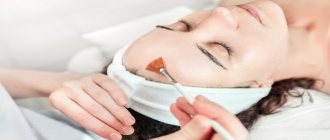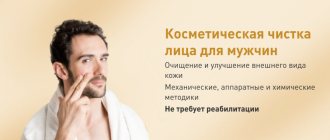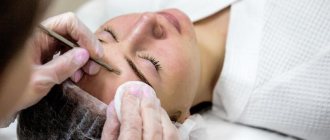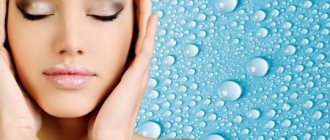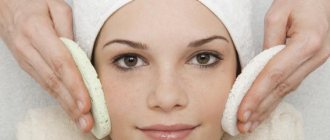From this article you will learn:
- Features of the facial peeling procedure
- Types of peelings for facial skin
- Chemical peeling for face
- Mechanical facial peeling
- Ultrasonic facial peeling
- Laser facial peeling
- Choosing the type of facial peeling based on age and skin type
Despite the large number of types of facial peels in cosmetology, they have similar tasks. Each helps cleanse and rejuvenate the skin. Depending on the depth of penetration, the substances included in the peels remove dead cells, stimulating regeneration.
The effectiveness of the procedure is also determined by the method of exposure. Some peels mechanically remove dead skin cells, while others dissolve them chemically. We will talk about the intricacies of using various types of peelings for the face and décolleté in this article.
Features of the facial peeling procedure
Translated from English, the word “peeling” means “to wash”, “to clean”. Therefore, this event is intended to deeply cleanse the facial skin, remove sebum and impurities, and eliminate dead cells from the surface of the skin.
After exfoliation of the stratum corneum, a renewed, fresh layer of epidermis appears. Young skin better absorbs oxygen and moisture, which normalizes metabolic processes, increases resistance to external negative factors, and improves cell nutrition.
There is an opinion that peeling is just a rejuvenating procedure. However, there are different types of facial peels that have their own characteristics. The basis for its implementation depends on the specifics of a particular procedure. General indications include:
- sagging and sagging skin;
- excessive pigmentation;
- the presence of a thick keratinized upper layer of the epidermis;
- consequences of acne.
Thanks to cleansing, age-related changes become less pronounced. Skin regeneration helps reduce deep or expression wrinkles. Peeling allows you to restore the structure of the skin layer, eliminating defects (microscars, age spots, various scars). In addition, during the procedure, the sebaceous glands and pores are cleansed, it serves as a prevention of inflammatory processes and acne.
Cleaning is not contraindicated for any skin type (dry, normal, oily).
Peeling is a fairly traumatic procedure, so it has a number of limitations:
- overly sensitive skin;
- presence of damage (wounds and abrasions on the face);
- age less than 18 years;
- acute stage of acne or herpes infection;
- pregnancy, lactation;
- tendency to allergies.
Peeling allows you to eliminate various defects and helps maintain healthy, fresh skin. The necessary conditions are the supervision of a professional and the implementation of all recommendations.
Before and after photos
Highly effective chemical peels do not always improve skin condition. Despite the strong impact and deep cleansing, such procedures are fraught with burns and irritation. Therefore, there is a more loyal, but no less effective way of cleansing and restoring the skin - Sea Needle peeling.
To make sure that it is harmless, and most importantly, that it has a targeted effect, you can look at photographs of patients in beauty salons before and after visiting the “sea” peeling procedure.
As can be seen from the result, salon peeling Sea Needle is absolutely harmless in most cases, but in some cases it can provoke the following consequences:
- dry skin;
- itching;
- redness;
- trauma to the upper layer of skin due to abrasive elements.
This outcome is only possible if the procedure is carried out incorrectly or the rules are not followed during the recovery period.
Types of peelings for facial skin
An experienced specialist will help you determine which type of facial peel to choose. The effect of the procedure depends on the depth of exposure of the drugs. The cosmetologist will assess the condition of the skin, the specifics of existing problems and recommend the most suitable option.
Name and description of the main types of facial peeling:
- Superficial peeling. The procedure involves cleaning only the upper layers of the epidermis, without affecting the living layers. The process of superficial peeling removes dead cells. There are practically no contraindications to this procedure, it is painless and does not cause complications.
- Medium peeling. Involves cleaning the entire skin layer. During the session, drugs penetrate deeper into the epidermis, which has a beneficial effect on metabolic processes. Medium peeling is performed only by a professional cosmetologist. After such manipulations, the skin needs intensive restoration.
This type of facial peeling in cosmetology is intended for rejuvenation. It helps eliminate large areas of pigmentation, reduce deep wrinkles, and get rid of old spots. After the procedure, minor burns and red marks remain, so the recovery period can be 3–4 days.
- Deep peeling. Quite a complicated procedure. All manipulations are performed only in a hospital setting with mandatory pain relief. In the process, all layers of the epidermis are destroyed. Tissues begin to regenerate from the remaining fragments.
Deep peeling (laser and chemical) is an aggressive cleaning method. This procedure immediately rejuvenates by 8–10 years, due to the almost complete burning of old skin and its replacement with new one.
The most common anti-aging procedure is medium peeling.
In order to refresh the skin, superficial cleaning is performed at least 2 times a month. To eliminate defects and prevent early age-related changes, medium peeling is performed twice a year.
Indications for deep peeling must be very serious.
There are the following types of peelings for cleansing the skin:
- chemical;
- mechanical;
- ultrasonic;
- laser.
Let's look at each type in more detail.
Luxury cosmetics that I didn't understand. Part 1
I cleared out the bins and I found a bunch of jars of luxury cosmetics that had been put aside “to think about,” but never got their chance. Therefore, I decided to write some useful posts about cosmetics that are not worth the money.
Helena Rubinstein Pure ritual Black peeling – Double action black peeling
At first glance, Black peeling from HR meets all the requirements that we expect from a luxury product: 1) good packaging made of expensive plastic, convenient lid, elegant design;
2) a pleasant smell and excellent texture, which transforms from a thick cream with small scrubbing particles into a gentle massage oil; 3) meditative ritual of application: the peeling should be rubbed in circular movements, massaging the face and turning it into oil. Everything seems to be perfect. Why am I throwing Black peeling from HR into the basket?
Are you too greedy?!
Firstly
, peeling is not effective.
Yes, it's fun to apply. Yes, facial massage is beneficial and some exfoliation is observed. But this peeling does not fight comedones or remove flaky skin. The only positive effect of Pure ritual Black peeling is that the mask works better after peeling. That's all about the effect: there is no “smooth - clean - renewed” skin. I note that Black peeling from HR costs 4,000 rubles
and you can easily find a more budget-friendly analogue that will not only prepare the skin for the mask, but will eliminate dead cells and cleanse pores much better than Pure ritual Black peeling can do.
For example: + papaya-pineapple peeling from Elemis for 2500 rubles, + enzyme peeling cream from Matis for 2000 rubles + smoothing cream peeling from Clarins for 2200 rubles, etc. etc... Is there any point in overpaying?
I'll show you with an example. It’s difficult to evaluate the removal of dead cells without a microscope, so let’s twist and see how the peeling works with a MAC lip pencil. I naively believe that if peeling cleanses the skin and pores of dirt and dead cells, then at least it can also cope with decorative... it's dirt... right? I will compare HR with a similar soft enzyme peeling from Elemis. Go…
1. Draw on your hands to indicate where each product will be (“HR” - for Pure ritual Black peeling and “El” - for Elemis)
2. Apply and rub until oiled Pure ritual Black peeling from HR, meanwhile apply papaya peeling from Elemis to the other hand and leave it for 10 minutes (I waited 5 minutes)
Do you need any more comments on efficiency?
Secondly
, the consequences of using Black peeling from HR can be sad. If you do not have perfect skin, but have at least one pimple (or a hint of a pimple), then after peeling from HR you will already have 3-4 inflammations. Therefore, I couldn’t apply Black peeling from HR even to save money. Seven or eight times I tried to give Black peeling from HR a chance and each time the use ended in a flower bed on my face.
Conclusions: Price - 4000 rubles (without discounts) Duration of use - lasts about a year, used 7-8 times Rating - 2.
Valmont Dermo Dermatosic – Treatment solution for sensitive skin
The purpose of this thing - other than reducing the volume of the wallet - remains unclear.
It should be applied pointwise to rashes and irritations. Dermatosic promises to eliminate inflammatory skin problems: redness, irritation, peeling, small rashes. In fact, Valmont Dermatosic fights rashes much like a schoolboy fights Karelin, and helps with irritations... at the level of panthenol. Valmont Dermatosic performed well as a home care after cleaning by a cosmetologist.
If you apply it all over your face 2 nights in a row, the cleansing effect will last longer and irritation will go away faster. Cool and useful... if you close your eyes to the fact that Panthenol with a similar effect costs 200 rubles, and Valmont 6000 rubles...
Conclusions: Price - 8,000 rubles (without discounts) Duration of use - intermittently, I used it all up in 8 months Rating - 3. There is an effect, but not for that price
La Colline Eye performance cellular vital eye mask - Eye contour mask with cellular complex
It seems to me that this mask has been discontinued... Hmm... well, okay, I’ll kick the man lying down... According to my observations, few really cool eye masks have been invented.
Many masks do a good job of removing bags under the eyes and helping with blue spots, but only a few struggle with wrinkles. I had high hopes for La Colline and they were partially justified. La Colline gives the “Cinderella effect”: relieves swelling, removes blue discoloration, smoothes out wrinkles. But the magic lasts for a day, and then Cinderella is back in the pumpkin. A course of using the La Colline mask did not remove the lines of dehydration under the eyes. In general, the mask from La Colline works faster and better than eye masks from Sisley or from Clarins, but without miracles... and for that kind of money we need a miracle... Objective disadvantages of the eye mask from La Colline - it is difficult to wash off and, judging by the reviews, many it causes allergic reactions (I didn’t have any allergies, but due to reviews about allergies, the mask has a low rating on foreign websites).
Among cream masks it is difficult to find an analogue of La Colline, but I think they should be there. Patches with a similar effect (and price) are available at Shiseido.
Conclusions: Price - about 7,000 rubles Duration of use - approximately 6 months Rating - 3. Points deducted for price-quality ratio and possible allergies.
Increase
Chemical peeling for face
- Superficial peeling
The procedure is carried out using fruit alpha-hydroxy acids (glycolic, lactic, citric, grape). Under the influence of chemicals applied to the surface of the skin, the keratinized cells of the epidermis dissolve. These drugs not only cleanse and activate skin tissue. They have the following positive properties:
- moisturize;
- relieve inflammation;
- normalize the functions of the sebaceous glands;
- tighten pores;
- disinfected.
Indications for the procedure are hyperkeratosis, acne, post-acne, oily skin, enlarged pores, signs of early age-related changes (minor pigmentation, shallow wrinkles).
To get a lasting effect, at least 10–15 sessions are needed. The frequency should be once a week.
- Medium peeling
This type of chemical peeling for the face in cosmetology involves treating the skin with trichloroacetic acid (25–30%) and salicylic acid (30%). The action of these substances is to dissolve the cell layers to the depth of the papillary layer. The skin's response to chemical irritation is swelling and redness. Skin tissue is restored within 7 days, during which the dead layer of cells peels off.
Recommended articles on the topic:
- How to increase skin elasticity: vitamins, exercises, creams and salon treatments
- How to remove wrinkles on the face: the most effective methods
- Microcurrent facial therapy is a beneficial treatment for your skin
Using medium peeling, age-related changes in the skin (wrinkles, age spots, decreased tone) are eliminated. In addition, chemicals have anti-inflammatory and disinfectant effects. Medium chemical peeling is effective in the complex treatment of acne, as it normalizes the function of the sebaceous glands. Another advantage of this type of acid peeling for the face is its ability to cope with scars and stretch marks.
- Deep peeling
As a rule, this procedure involves the use of drugs that contain phenol. The substance affects the deep layers of the epidermis down to the middle layer. The effect is a significant renewal of the skin. Most often, men and women after 40 years of age undergo phenol peeling to correct pronounced age-related skin changes.
The basis for this procedure is the presence of:
- wrinkles, nasolabial and eyebrow folds, creases in the lips and eyes;
- excessive pigmentation;
- sagging, sagging skin;
- scars, scars, stretch marks;
- photoaging process.
The rehabilitation period after deep peeling lasts at least 4–6 weeks. To avoid complications, patients should strictly adhere to all medical recommendations regarding preparation for peeling and skin care after the session. At the end of the rehabilitation period, the face looks approximately 10 years younger. After one procedure, the result lasts for several years.
Contraindications to phenol peeling are severe heart and vascular diseases, liver and kidney diseases.
What is the difference: home peeling and peeling at a cosmetologist
Peels that can be used at home do not penetrate deeply into the skin and give an unnoticeable result, but they certainly help maintain an even tone and healthy skin. Chemical peels performed by estheticians have a lower pH level than at-home peels, so they can penetrate much deeper into the skin and target skin problems such as hyperpigmentation and acne. Chemical peels can cause redness of the skin; a recovery period will last for several days, during which the “old” skin will gradually peel off and renewed skin will appear.
Chemical peeling performed by cosmetologists will be much more effective for your skin than peeling at home.
Mechanical facial peeling
This type of manual peeling is considered the easiest way to cleanse the face. The procedure involves mechanical removal of the top layer of the epidermis using abrasives. The preparations used contain hard granules to quickly eliminate dead cells. Such means include:
- Scrub. Available in the form of a gel or cream with abrasive particles. The product is applied to the face, after which it is washed off along with dead cells. It is important to try not to injure the skin during the scrubbing process.
- Gommage. Designed for cellular nutrition and regeneration. The product is a rolling cream with soft abrasive particles or fruit acids that dissolve during cleaning.
- Brushing (brossage) to exfoliate the dead layer of the epidermis. To perform the procedure, you need a special hard brush with synthetic bristles. The face is covered with abrasive paste, then massaged with a brush.
- Salt peeling. The procedure is performed using products containing table or sea salt, rich in macro- and microelements.
- Coral polishing. The products used during the procedure contain coral chips and plant components.
- Film masks for removing dead cells from the skin. The product is a special silicone film that is applied to the face and then removed along with the stratum corneum.
With the help of manual mechanical cleaning, impurities are removed from the surface layer, the skin becomes fresh, and shallow wrinkles are smoothed out.
We recommend
Laser aesthetic cosmetology: the perfect technique for an ideal appearance More
In the beauty salon, specialists perform medium mechanical peeling, which includes microcrystalline dermabrasion and diamond exfoliation. Using these procedures, minor scars, scars, slight pigmentation, and post-acne are eliminated.
Operating principle and effectiveness of Sea Needle peeling
Peeling Sea Needle is the brainchild of Israeli manufacturers, based on organic elements. The composition includes sea salt, algae, minerals, proteins, plant components, and marine plant extracts.
The principle of action is localized cleansing and restoration of damaged epidermis. Microelements promote the resorption of scars and protect the skin from external irritants. Plant components have antiseptic properties and strengthen capillaries. The exfoliating effect of peeling is provided by sea salt, the main component of the product.
In addition, natural substances solve the following skin problems:
- withering and photoaging;
- loss of turgor and elasticity;
- acne and post-acne;
- pigmentation;
- scars;
- stretch marks;
- lentigo.
Active components help remove toxins from contaminated pores and tighten enlarged pores. The effectiveness of this procedure is also manifested in stimulating regeneration processes: exfoliating the top layer of keratinized cells and penetrating deeper, the formation of new cells is formed at the tissue level.
Sea Needle Peeling is a slightly painful but safe procedure that does not provoke allergies or adverse reactions. Moreover, such a cleansing and restorative manipulation is suitable for both women and men and does not contain age restrictions.
Ultrasonic facial peeling
This type of peeling refers to hardware procedures for surface cleaning, which involves removing dead cells and cleansing contaminated pores.
Laser facial peeling
This type of peeling involves exposing the epidermis to a laser beam. Depending on the type of radiation, as well as the depth of laser penetration, one or another result is achieved.
Contraindications to this type of facial peeling in cosmetology for problem skin:
- oncological diseases;
- cardiovascular diseases;
- infections;
- pregnancy;
- impaired blood clotting;
- presence of fillers in the treated area;
- connective tissue diseases, autoimmune diseases.
Peeling helps in solving a variety of aesthetic problems. To achieve maximum effect, you need to focus on your skin type. In addition, it is important to strictly adhere to the technology of performing the procedure.
Retinoic yellow peeling: indications and contraindications
Indications
for the use of retinoic yellow peeling:
- The appearance of small wrinkles;
- Heavy pigmentation caused by long exposure to the sun;
- Loss of elasticity and firmness;
- Insufficient collagen production;
- Acne;
- Skin aging;
- Insufficient skin hydration;
- Hyperkeratosis;
- Need for bleaching;
- Hyperpigmentation.
The retino yellow peel also has several other benefits. It has a lifting effect, gives the skin a smoother appearance and improves relief, removes any impurities from the surface, and stimulates anti-inflammatory processes. The external condition of the skin improves and a healthy glow appears.
Contraindications
for the use of retinoic yellow peeling:
- Allergic reactions that may be caused by the use of retinol;
- Incompatibility with other medications: this peeling can only be done six months after taking Roaccutane.
- The presence of viral infections, which, together with retinoids, can cause a herpes rash;
- Liver disease, as well as previous hepatitis;
- Increased skin sensitivity, which may be indicated by problems such as atopic skin reactions, seborrheic dermatitis, eczema;
- Photosensitivity – high sensitivity to solar or other radiation with a UV component;
- Pregnancy and planning in the coming year, as well as the lactation period;
- Presence of warts.
Choosing the type of facial peeling based on age and skin type
When choosing the type of superficial (or other) facial peeling in cosmetology, it is customary to take into account two important factors: the age of the client and the specifics of the problem.
Depending on the degree of skin aging, the optimal type of cleansing is selected:
- 21–25 years old. At this age there are no significant changes yet. Only pigmentation may appear. Experts recommend gommage or scrubbing, enzyme cleansing, and peeling using fruit acids.
- 25–35 years old. This period is characterized by the appearance of facial wrinkles, keratosis, and age spots. Cosmetologists recommend cryopilling, laser or superficial chemical peeling.
- 35–50 years old. At this age, changes in the condition of the skin become clearly visible: dull complexion, pronounced pigmentation, capillary network. Laser cleaning and vacuum peeling are recommended.
- More than 50 years. This period is characterized by the presence of many wrinkles and creases of varying depths. After 50 years, the skin needs deep chemical peeling and laser cleaning.
For mature facial skin after 40 years, cosmetologists recommend dermabrasion, mid-level professional laser or ultrasonic peeling.
- For oily skin, diamond peeling, coral mechanical or dry cleansing is suitable.
- For problem skin, salicylic or almond peels are performed.
Cosmetologists consider peelings to be an effective remedy that helps maintain skin health and renew it. Thanks to the procedure, skin tissue rejuvenation occurs quickly, skin tone increases, wrinkles are smoothed out.
If you perform peelings regularly, there will be no need for plastic surgery to restore and rejuvenate the skin.
The downside of these procedures is the risk of complications in the form of intense pigmentation, spider veins, and tissue scarring in the area of severely damaged or burned skin.
To avoid unforeseen consequences during cleansing or restoration, you need to contact trusted beauty salons. In addition, it is necessary to choose only high-quality drugs.
Why clients choose Veronika Herba Beauty and Health Center:
- This is a beauty center where you can take care of yourself at a reasonable cost, while your face and/or body will be treated not by an ordinary cosmetologist, but by one of the best cosmetologists in Moscow. This is a completely different, higher level of service!
- You can receive qualified help at any time convenient for you. The beauty center is open from 9:00 to 21:00, seven days a week. The main thing is to agree with your doctor in advance on the date and time of your appointment.
Sign up for a consultation with a specialist by phone +7 (495) 085-15-13
, and you will see for yourself!
How to prepare for the procedure
The preliminary stage requires the following basic steps to be carried out sequentially: diagnosis and history taking, skin examination, conversation with the patient, informed consent and pre-peel preparation.
Let's look at each stage separately. When a client first comes to the doctor and says that he wants to undergo the retino yellow peeling procedure, he is scheduled for an examination, during which his skin type is determined and his general condition is analyzed. The conclusion should contain such items as the presence of scars, elastosis, inflammation, signs of photoaging, and pigmentation disorders.
The doctor creates a patient record, which includes photographs reflecting the appearance of the skin before peeling. The signed informed consent is also included there. The medical history includes information about the sun exposure regimen recommended for the client during the preparatory period.
The doctor needs to find out how the patient took care of his skin. He should be asked the following questions:
- Has the client ever tried self-peeling using retinols and what was the skin reaction?
- What diseases was the patient being treated for?
- Do you have any allergies?
- Did you have diseases such as seborrheic dermatitis, eczema, rosacea?
- Have there been any cases of viral hepatitis or other liver problems?
- About pregnancy or planning a child in the near future. If the answer is yes, then peeling cannot be done.
- Are there any warts on the areas of the skin where the retinoid mask will be applied?
- Are there any signs of skin photosensitivity? If so, the patient must be careful to avoid contact with sources of UV radiation (the sun, various lamps, solariums or other artificial tanning facilities).
During the first examination, you need to thoroughly clean the skin and carefully examine. Using a magnifying glass, the doctor looks for signs of diseases on the skin for which the retino yellow peeling procedure cannot be performed. These are viral warts, herpes, molluscum contagiosum. Skin color is assessed and its type is determined.
The next stage is a conversation with the patient. The client talks about the results he wants to achieve. This could be getting rid of fine wrinkles, removing age spots or scars, reducing pores, overcoming roughness, acquiring a brighter skin color or lightening it. The patient is also shown photographs of other people who have already undergone this procedure. The client talks about whether he is satisfied with everything and whether he wants to achieve the same results.
Next, in accordance with the wishes of the patient, the doctor designates those areas of the skin that will be subject to application of a mask with retinoids. The doctor is obliged to inform the person about what the recovery period will be after the procedure, so that the client knows that his skin will probably return to its normal appearance within two weeks, that it will first peel off a lot, then turn red and become more sensitive. Depending on the results that the patient needs, the doctor may recommend a course of several sessions of retinoic yellow peeling.
If the client is satisfied with everything and agrees to the procedure, informed consent is read out to him on a voluntary basis. He signs two copies: one for himself, the second for the institution. Such documents are needed to avoid possible conflict situations in the future.
Next, the skin begins to prepare for peeling. In patients with normal skin type, this process takes about two weeks. Dark-skinned people need four weeks to determine the safe interval for using products with retinoids, since this type of epidermis has an increased sensitivity to the effects of such drugs.
A very good preparation for the skin would be to use cosmetic products containing retinoids (0.025-0.1% tretinoin) at home.






